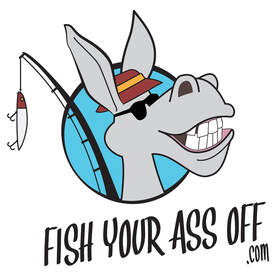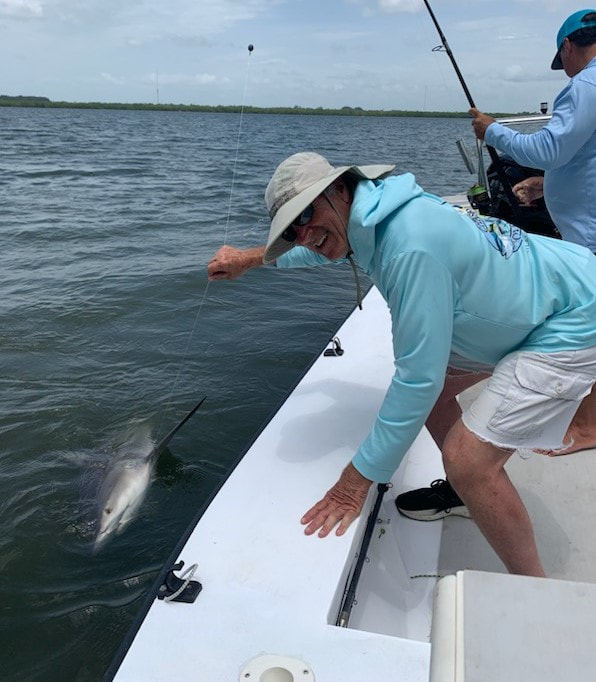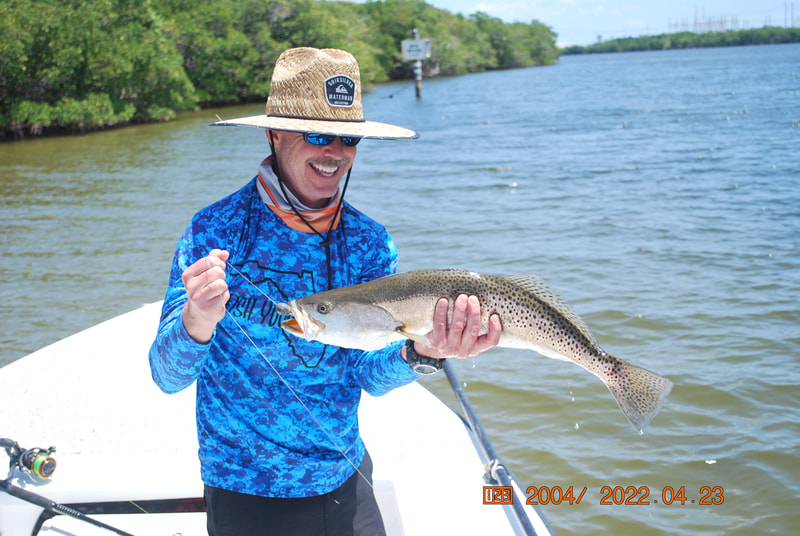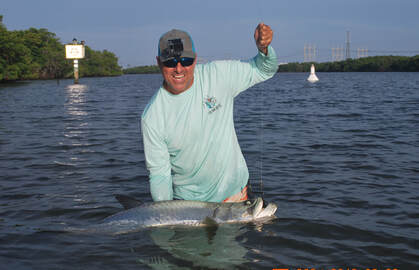
What are the Best Baits and Lures for Flounder Fishing Florida?
The best baits for flounder are finger mullet, white baits and mud minnows fished within 12 inches of the bottom. The best lures for flounder are gulp swimming mullet and bucktail jigs with a 1/4 ounce to a 1/2 ounce jig head fish very slowly.
Flounder are an extremely popular fish for fishermen everywhere. Up north they are usually called fluke but down here in Florida we call them flounder. We have two different species to offer to Florida flounder pounders.
BUT if you want to catch your fair share of flounders then you will need to use the best baits and lures to catch them with.
The two types of flounders come in different sizes. The Southern flounders are around 20 inches and the Gulf flounders are usually around 14 inches.
You can tell the Gulf flounders because they have 3 distinct black spots on their backs. The Southern ones have dark spots all over the place.
Flounders have a strange life cycle because they begin life looking like a normal fish with an eye on either side of its face. Their right eye will slowly migrate around to the left side of their heads to better suit their lives as a bottom dwelling predator.
They must be doing something right because they are very abundant from the Gulf of Mexico all the way up the Atlantic Ocean side to North Florida.
I am an INSHORE FISHING GUIDE on the Treasure Coast of Florida. I have been fishing the oyster bars and mangroves around Florida for over 40 years.
The article below will teach you simple tips and techniques to help you catch more flounders. Let's get started.
Watch the video below and use the best baits and lures to catch more flounder.
The best baits for flounder are finger mullet, white baits and mud minnows fished within 12 inches of the bottom. The best lures for flounder are gulp swimming mullet and bucktail jigs with a 1/4 ounce to a 1/2 ounce jig head fish very slowly.
Flounder are an extremely popular fish for fishermen everywhere. Up north they are usually called fluke but down here in Florida we call them flounder. We have two different species to offer to Florida flounder pounders.
BUT if you want to catch your fair share of flounders then you will need to use the best baits and lures to catch them with.
The two types of flounders come in different sizes. The Southern flounders are around 20 inches and the Gulf flounders are usually around 14 inches.
You can tell the Gulf flounders because they have 3 distinct black spots on their backs. The Southern ones have dark spots all over the place.
Flounders have a strange life cycle because they begin life looking like a normal fish with an eye on either side of its face. Their right eye will slowly migrate around to the left side of their heads to better suit their lives as a bottom dwelling predator.
They must be doing something right because they are very abundant from the Gulf of Mexico all the way up the Atlantic Ocean side to North Florida.
I am an INSHORE FISHING GUIDE on the Treasure Coast of Florida. I have been fishing the oyster bars and mangroves around Florida for over 40 years.
The article below will teach you simple tips and techniques to help you catch more flounders. Let's get started.
Watch the video below and use the best baits and lures to catch more flounder.
Best Baits and Lures for Flounder Fishing--INLETS
The inlets around Florida are a great place to target flounders. Flounders are a very structure oriented type of fish. They like to set up ambush points near the big boulders that line most of the inlets around Florida. You can count on them facing into the current from their camouflaged position so they can pounce on unwary prey that comes to them. They will chase a fish or shrimp but usually not very far.
The best live bait for big inlet flounder is a finger mullet. The set up that seems to work best is a simple sliding egg sinker on the line above the hook. Just cast the weighted bait up current and let it slowly come back to you with the tide. If there are flounder in the area they are not very picky when it comes to finger mullet.
They will also take a large live shrimp, mud minnow, a pin fish or a white bait presented with a similar technique. The key to live baiting inlets for flounder is casting up current near the structure.
The best lures for fishing the inlet boulders is a scented shrimp or shad paddle tail soft plastic with a jig bounced along the bottom as close to the rocks as possible. The heavier currents in the inlets will mean that you will need more weight to get the lure to the bottom.
I created a FREE Online Fishing Course that covers in great detail the best baits and lures to catch flounders with. You can access the fishing course by clicking right here.
A shrimp tipped 1 to 2 1/2 ounce feather jig will also get lots of bites if the flounder are around. Use the same jig technique and cast up current and bounce your jig on the bottom as you slowly bring it back to your position. If there is not a lot of people fishing the inlet you can start a one end and work your way up the rocks casting up current the whole time.
Watch the video below and learn about the Gulp Shrimp for flounder.
Best Baits and Lures for Flounder Fishing--DOCKS
Most of the flounder that I catch are around docks from my kayak using artificial lures, but I know what live baits work best in my area. A live shrimp under a small split shot will catch tons of flounder if they are around. Try to cast your bait right at or under the dock for best results. If you are in a region of Florida with lots of mud minnows use those if you can get some live ones.
Let your shrimp or mud minnow offering sit for a few minutes before re positioning yourself a few more dock pilings down and repeat the process for the whole dock. Methodically fish each and every dock this way to maximize your results. When you start catching flounder note the water depth that the fish are in and focus your efforts on that depth.
The best lure for flounder fishing around docks is a scented shrimp imitation like a Berkeley Gulp. I like a white one with a red 1/8 ounce jig head. The GULP shrimp and the GULP swimming mullet are the only lures that you need to catch flounder. These baits will often out fish live bait so don't even bother getting any if you are flounder fishing.
Take your time retrieving your jig. I will cast the jig as far as I can and let it sink. I will bounce the bottom for a few feet and let it sit for 15-20 seconds and then bounce it some more. I will repeat this over and over until I'm ready to cast out and repeat the process again.
Slow and low will win the flounder catching race. If you think that you are retrieving your bait too slowly, you are wrong. There is no such thing as too slow when flounder fishing.
BEST ALL AROUND ROD AND REEL COMBO FOR FLOUNDER
In my opinion, the perfect all around rod and reel combo for flounder is a 3500 series reel and a 7 foot medium or medium/light strength, fast action rod. Fill the spool with 15 pound braided line and use a 20 pound leader.
I have used many different rods and reels over the last 40 years of fishing like Diawa, Shimano and Penn.
My favorite line of reels that are out now is the Penn Spinfisher series reels. They are smooth, tough; have great drag systems; and best of all a sealed body so sand and water don't get inside the reels.
They are perfect for surf fishing, wade fishing and kayak fishing. (Any fishing technique that makes it likely for water or sand to get in them)
You can expect to pay $150 plus for these reels. BUT they are worth it.
My second favorite non-sealed reels are the Diawa BG reels.
They are the reels that I use on my flats boat because I know that they are unlikely to get dunked in the water or to get beach sand in them.
You can expect to pay $100 plus for these reels. They are a great bargain in my opinion.
Flounder fishing is a patient man's game. Don't get in a hurry and you can catch a lot of fish. Remember that the flounder's strike zone is within about 12 inches from the bottom. Some of the more energetic ones will swim up a few feet if they are really hungry but most will not put in that kind of effort.
A shrimp tipped feather jig and a gold spoon are also great lures for catching flounder. I probably sound like a broken record at this point but the key is a slower retrieve that keeps the bait within 12 inches of the bottom. I am not sure if there is such a thing as too slow of a retrieve when fishing for flounder, BUT there is such a thing as fishing too fast.
The video below is about the best lures for flounder fishing in Winter.
Watch the video below and catch more flounder wade fishing around docks.
Best Baits and Lures for Flounder Fishing--GRASS FLATS
Flounder love to hide in the sandy pot holes that dot all of the grass flats around Florida. The best live baits for this environment are shrimp and small white baits with a small weight or split shot. White baits include herring, menhaden, sardines and any other small shiny little fish.
Sink that bait in the middle of one of those sandy spots and wait a few minutes to see if there is a flounder or two buried under the sand somewhere in the pot hole. Keep hitting those pot holes remembering to present your bait from up current.
Use the same scented jigs, shrimp tipped feather jigs and gold spoons for the grass flats like you would for the docks. Send your jigs and spoons up current and bounce them slowly through every sandy pot hole that you can find to load up on whatever flounder are in the area.
WANT TO CATCH FLOUNDER? BOOK YOUR FISHING CHARTER TODAY!
Best Baits and Lures for Flounder Fishing--OYSTER BARS/MUD FLATS
Flounders like to set up shop in the cuts between oyster bars and mud flats when they are hunting around creek and river mouths. In this environment live shrimp and mud minnows are the best live baits to use. A shrimp or a mud minnow with a split shot works great.
Many fishermen swear by the shrimp or mud minnow on a jig head rig. I have never tried this technique but I know for a fact that it works well. Send your live bait offering up current and bounce it back slowly with the tide for the best results.
You definitely want to use a braided line when fishing for flounder. Their strikes are often hard to feel so a more sensitive line will help you set the hook better. You have to set the hook very quickly when catching flounder because they will spit it out. They hold onto live bait longer so you should wait to set the hook with live bait.
This is another great environment to use the scented soft plastic shrimp jig, the shrimp tipped feather jig and the gold weedless spoons. Cast up current and bounce them slowly back to you with the current. If there are hungry flounder in the area, you will find out about it soon enough.
Best gear for flounder fishing:
If you are going to be fishing for flounder all day you will definitely need to protect your eyes and skin from the sun's harmful rays. Polarized sunglasses are a must for flounder fishing. They will let you see them when they are on the move.
A high end pair of sunglasses will run about $250 and a lower end pair will run you about $25 with glass lenses. You can find them with plastic lenses for about $5 at Walmart. You have to decide on what level of sunglasses that you want but the expensive ones are better. The frames are very sturdy and the lenses are usually glass and scratch resistant.
Whatever price range you decide to go with you must wear polarized sunglasses or you can not sight fish for flounder around the docks or on the flats. The polarized lenses eliminate most of the glare on the surface of the water so that you can see under the surface.
You won't necessarily be able to see the flounder because they are often hidden under mud, sand or gravel but you can see the bait that they are feeding on.
The best color lenses for inshore and dirtier water scenarios are amber, rose and copper. If you are fishing super clean and clear water or you are fishing offshore a blue or a gray lens is best.
You will also want to stock up on UV performance fishing shirts to protect your skin from the sun's harmful rays. These shirts have built in sunscreen and are moisture wicking which means they evaporate your perspiration more efficiently keeping you cool on those hot days on the water.
How to use smell to catch more flounder.
I think that many fishermen forget how important a fishes sense of smell is to them. I am not talking about the fishermen's sense of smell. I am talking about the flounder's sense of smell.
Think about how a flounder perceives its underwater world. It has eyes on the top of its head to see what going on around it. It had a lateral line to feel/hear its environment and it has an olfactory system to smell/taste its environment.
Let's say that your go to flounder lure is a gold spoon. Gold spoons work very well for flounder but I am going to use that lure to prove a point about incorporating a flounder's sense of smell.
Let's assume that you are fishing in a dark and murky tidal creek around some oyster bars. The water is too murky for the flounder to use its eyes effectively to find your lure. It certainly can't smell your spoon. This means that it is solely relying upon its lateral line to find the lure.
Why not add another of the flounder's senses to this scenario? There is a product called Pro Cure that is a sticky liquid with many delicious smells to choose from. I recommend the shrimp and the mullet scents.
You can add these scents to your lures to incorporate more of the flounder's senses.
I wrote another article on this website that covers in great detail the scents that attract and repel fish. You can read that article by clicking right here.
Why do you think that Berkely Gulps work so well? It incorporates ALL of the flounder's senses. This gives you a higher probability of getting the flounder to bite your lure.
I am not sponsored by Pro Cure, Mirro Lure, Berkely Gulp or any other brand that I talk about in my articles. I only mention them to you because they work.
Watch this video and catch more flounder.
Conclusion:
Flounder are one of those fish that are hard to catch for many anglers. The techniques that work are very different from other species of fish. Most anglers fish way to fast and too far off of the bottom to catch many flounder.
If you want to catch a ton of flounders, then you will need to know the best baits and lures to catch them with. Hopefully this article will help you do that.
Flounder respond best to bait presentations that are moving very slowly within a foot or so off of the bottom. The biggest mistake that most fishermen make is a presentation that is too fast. You barely want to move your lure or live bait across the bottom.
It is also very hard to feel the flounder's strike. If your bait all of a sudden stops for no reason, then you had better set the hook. Sure you might set up on an oyster or a rock some of the time but you will catch more flounder too.
If you are ever down in the Treasure Coast of Florida book a flats boat charter with me. Flounder are one of the fish that we catch along with snook, spotted sea trout, redfish and tarpon.
I hope that this article helps you catch more flounder or at the very least allows you to have more fun fishing for them. Let's get some lines wet.
About the author: The author of this article insists that everyone call him The Mac Daddy Flounder Pounder. BUT everyone just ignores him and calls him Mike, the co-owner of FYAO Saltwater Media Group, Inc.
If you like how to fishing articles like this one, then get on our email list below. We will send you a new fishing article every week.
Want to catch more flounder?
Get 1 new how to fishing article or video every week!
Just fill in your email below and check your inbox once a week.
- Learn the best baits and lures.
- Learn when and where to find flounder.
- Learn how to consistently catch more flounder.
Get 1 new how to fishing article or video every week!
Just fill in your email below and check your inbox once a week.
Bonus Video: Catch and Release Ethics and Techniques



